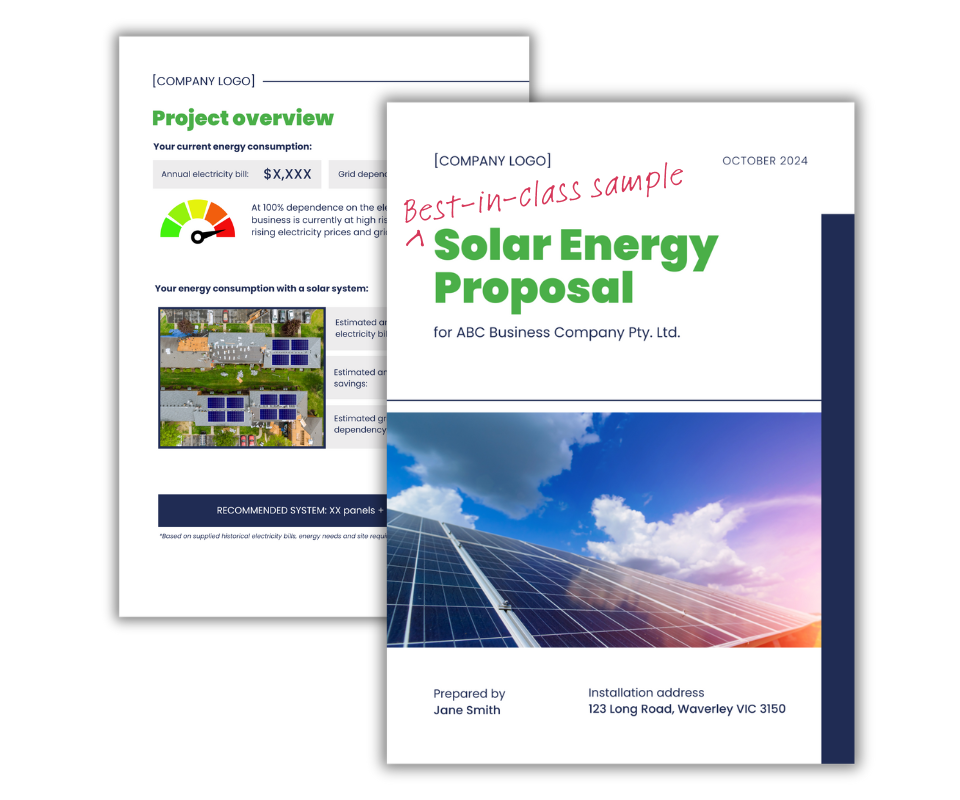We’ve analysed hundreds of solar proposals to put together our own sample solar proposal, featuring the key best-practice components that will help you close deals.

Enter your details to download a sample of our best-in-class sample solar proposal.
The 5 key components of a best-in-class proposal
We’ve seen a lot of solar proposals in our time, from snappy one-pagers to weighty, multi-chapter epics.
And there’s one unfortunate thing many of them seem to have in common. They tend to forget their main purpose – to serve as an effective sales tool and help the customer decide to buy.
The proposal stage is a good stage to be in. It shows high intent from your prospect who is interested in learning more about how your services could help them. But interest does not equal conversion – and you need to keep them on the hook. Your proposal will either push them over the line or push them away.
So, what are the key components of a good proposal?
1. Front load the tangible benefits
Instead of concentrating on the technical details of the project, highlight these points:
- What pain are they avoiding?
- What tangible benefits will your prospect enjoy?
Within the first couple of pages of your proposal, your prospect should be convinced that their business will be better off by decarbonisation.
You can leave the technical stuff for later. (Better yet, stick it in the appendix as a “nice to know”.)

2. Make it make sense
The fix?
- Use easy-to-understand, non-technical terms when explaining solar systems. Instead of ‘Net Financial Impact’ try ‘How much money you will save’; instead of ‘Discounted Payback Period’ try ‘How long will the system take to break even?’
- Use icons, images and infographics throughout your proposal. These can be more engaging than text alone, as they capture and hold attention longer.
- Choose graphs over tables. Seeing pre- and post-solar energy bills in a graph format makes it much easier to visualise savings.

3. Present the cost obstacle as a savings opportunity
This is where integrating Smart Ease Payment Plans is key. With the option of a Payment Plan, your client can invest in a solar system without paying any upfront capital, and instead pay for the system over time through the energy savings generated from the solar system.
Around 90% of Smart Ease users are cash-flow positive from the start of their plan, meaning their monthly energy savings are greater than their monthly repayments – so they have cash left over to spend on revenue-generating activities.
If you can convey this saving opportunity in your proposal, your prospect will see it as a no-brainer!

4. Tailor it for each client
Just like solar systems are customised for each site, a solar proposal should be tailored for each customer. If your prospect is comparing proposals, the one that will stand out is the one that has fully understood and considered the specific needs of their project.
What industry is your prospect’s business in? What’s their energy use like? Do they plan to expand in the near future? Ask these questions ahead of time and address in your proposal.

5. Perfect your presentation
Never underestimate clear and effective design. When comparing similar proposals, having an easy-to-read, well-presented proposal document might be the tie breaker that gets you the job.
Similarly, part of presenting your proposal is actually presenting it. Don’t just press send and wait to hear back. Call your prospect, explain the value proposition you’re offering them, answer questions, and welcome the opportunity to walk the client through the proposal in person.
Engaging meaningfully with your prospect is professional and reassuring – and will go a long way towards convincing them you’re the right installer for their job.

